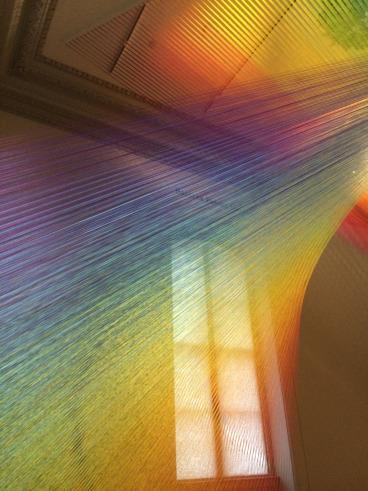
Plexus A1, Gabriel Dawe, Renwick Gallery
In 2015, it was a privilege to take part in a conversation with all of you on interfaith families and interfaith identities. Looking back over the past year, I chose what I see as seven of the most important themes from this conversation. I welcome your comments, or suggestions for stories I may have missed.
- Rabbis in Interfaith Relationships. The Reconstructionist Rabbinical College, the seminary of the fourth-largest Jewish movement, changed their policies this year in order to allow the admission and ordination of students in interfaith marriages or partnerships. While the smaller Jewish Humanist and Jewish Renewal movements have long accepted such students, this shift marks a significant moment in the history of accepting interfaith families in Jewish leadership.
- Progressive Protestants and Interfaith Identities. Historically, the topic of interfaith families (at least in the US) has been viewed mainly through Jewish, and to a lesser degree Catholic, lenses. So it was exciting when I was invited this year to speak at both a chapel service and an evening panel at Union Theological Seminary in New York. And it was also exciting that the World Council of Churches and United Church of Christ convened a series of consultations on Religious Hybridity, bringing together mostly Mainline Protestant clergy and theologians to discuss how to engage with people with multiple religious bonds. I was honored to be asked by Reverend Karen Georgia Thompson to present my research on identity formation in interfaith children raised with both family religions. I look forward to reviewing a new book (publication date tomorrow!) filled with related essays, Many Yet One: Multiple Religious Belonging.
- Unitarian Universalists and Interfaith Families. While Unitarian Universalists (UUs) have long welcomed interfaith families and people of complex religious identities, this year they took that support to the next level, with new resources on interfaith families in the UU world on their website and in a new pamphlet. I spoke about interfaith families at two UU communities this year, and on a UU podcast. And UU religious educators invited me to give the keynote Sophia Lyon Fahs lecture at the UU General Assembly, highlighting the important history of interfaith families in UU communities. The lecture was recently published in an eBook by Skinner House press.
- Interfaith Families and the Rise of the Unaffiliated. This year, Pew Research highlighted the steep rise in the religiously unaffiliated, from 16% in 2007 to 23% in 2014. Clearly, interfaith families are a part of this complex story, with some of us who are doubly-affiliated lumped in with others who are alienated from all religious institutions. Robert P. Jones of Public Religion Research Institute recently told a White House gathering on religious pluralism that 25% of people in the US said they had a spouse from a different religious background, and 16% said they follow the teachings or practices of more than one religion. This year also saw the publication of The Nones Are Alright: A New Generation of Believers, Seekers, and Those in Between, in which Kaya Oakes writes that future children are “increasingly likely to grow up ‘both/and’,” rather than either/or.
- Jewish Communities Engaged with Interfaith Families Doing Both. A slow thaw continues between Jewish institutions, and the 25% of Jewish parents in interfaith families educating children in both religions. For me, signs of this gradual warming trend (which I first noted last year) this year included invitations to speak at the Museum of Jewish Heritage, on The Jewish Channel, in synagogues and JCCs, at Hillel-sponsored talks, and at The Jewish Museum (coming up in February). I also enjoyed a year (sadly, over now) of being a columnist for the Jewish Daily Forward.
- Interfaith Families as a Global Rights Issue. While interfaith families in the US enjoy the freedom to marry across lines of faith, not all couples have this right. Many countries still register the religious identity of citizens, and allow religious institutions to control marriage and the religious identity of children. But the global connectivity is helping to highlight the importance of civil marriage as a universal human right. On twitter this year (follow me @beingboth) I came across an interfaith romance novel banned from schools in Israel, a court case over the religion of interfaith children in Malaysia, legislation to restrict interfaith marriage and conversion in Myanmar, the battle to recognize interfaith marriages in Indonesia, and interfaith couples violently attacked by religious extremists in various countries.
- Launch of the Network of Interfaith Family Groups (NIFG). In Being Both: Embracing Two Religions in One Interfaith Family, I chronicle the rise of communities formed by and for interfaith families to deliver interfaith education to their children, principally in NY, DC and Chicago. Since the publication of Being Both in 2013, I have been contacted by couples around the country and the globe, seeking to find or create interfaith family communities. In response, I launched the NIFG facebook page this year, to help couples who want to celebrate both family religions to find like-minded couples nearby. Already, we launched a new Atlanta facebook group filled with interfaith families who found each other through NIFG. At NIFG, you can find contacts listed from throughout the US, from California to Florida, and Wisconsin to Richmond. If you plan to raise children with both family religions (that’s any two religions), join us!
Susan Katz Miller’s book, Being Both: Embracing Two Religions in One Interfaith Family is available now in hardcover, paperback and eBook from Beacon Press.

